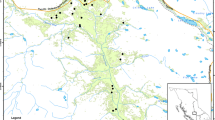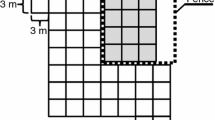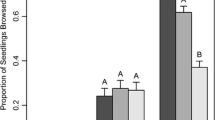Abstract
Plant–plant interactions can be a complex mixture of positive and negative interactions, with the net outcome depending on abiotic and community contexts. In savanna systems, the effects of large herbivores on tree–grass interactions have rarely been studied experimentally, though these herbivores are major players in these systems. In African savannas, trees often become more abundant under heavy cattle grazing but less abundant in wildlife preserves. Woody encroachment where cattle have replaced wild herbivores may be caused by a shift in the competitive balance between trees and grasses. Here we report the results of an experiment designed to quantify the positive, negative, and net effects of grasses, wild herbivores, and cattle on Acacia saplings in a Kenyan savanna. Acacia drepanolobium saplings under four long-term herbivore regimes (wild herbivores, cattle, cattle + wild herbivores, and no large herbivores) were cleared of surrounding grass or left with the surrounding grass intact. After two years, grass-removal saplings exhibited 86% more browse damage than control saplings, suggesting that grass benefited saplings by protecting them from herbivory. However, the negative effect of grass on saplings was far greater; grass-removal trees accrued more than twice the total stem length of control trees. Where wild herbivores were present, saplings were browsed more and produced more new stem growth. Thus, the net effect of wild herbivores was positive, possibly due to the indirect effects of lower competitor tree density in areas accessible to elephants. Additionally, colonization of saplings by symbiotic ants tracked growth patterns, and colonized saplings experienced lower rates of browse damage. These results suggest that savanna tree growth and woody encroachment cannot be predicted by grass cover or herbivore type alone. Rather, tree growth appears to depend on a variety of factors that may be acting together or antagonistically at different stages of the tree’s life cycle.




Similar content being viewed by others
References
Angassa A (2005) The ecological impact of bush encroachment on the yield of grasses in Borana rangeland ecosystem. Afr J Ecol 43:14–20
Archer S (1995) Tree–grass dynamics in a Prosopis-thornscrub savanna parkland—reconstructing the past and predicting the future. Ecoscience 2:83–99
Archer S, Schimel DS, Holland EA (1995) Mechanisms of shrubland expansion—land-use, climate, or CO2. Clim Change 29:91–99
Augustine DJ, McNaughton SJ (2004) Regulation of shrub dynamics by native browsing ungulates on East African rangeland. J Appl Ecol 41:45–58
Belsky AJ (1994) Influences of trees on savanna productivity: tests of shade, nutrients, and tree–grass competition. Ecology 75:922–932
Belsky AJ, Mwonga SM, Amundson RG, Duxbury JM, Ali AR (1993) Comparative effects of isolated trees on their undercanopy environments in high- and low-rainfall savannas. J Appl Ecol 30:143–155
Bertness MD, Callaway RM (1994) Positive interactions in communities. Trends Ecol Evol 9:191–193
Bertness MD, Ewanchuk PJ (2002) Latitudinal and climate-driven variation in the strength and nature of biological interactions in New England salt marshes. Oecologia 132:392–401
Bond WJ, Midgley GF, Woodward FI (2003) The importance of low atmospheric CO2 and fire in promoting the spread of grasslands and savannas. Glob Change Biol 9:973–982
Callaway RM, Nadkarni NM, Mahill BE (1991) Facilitation and interference of Quercus douglasii on understory productivity in central California. Ecology 72:1484–1499
Callaway RM, Brooker RW, Choler P, et al. (2002) Positive interactions among alpine plants increase with stress. Nature 417:844–848
Coe M, Beentje H (1991) A field guide to the acacias of Kenya. Oxford University Press, Oxford
Dean WRJ, Milton SJ, Jeltsch F (1999) Large trees, fertile islands, and birds in arid savanna. J Arid Environ 41:61–78
Dickie IA, Schnitzer SA, Reich PB, Hobbie SE (2005) Spatially disjunct effects of co-occuring competition and facilitation. Ecol Lett 8:1191–1200
Dublin HT, Sinclair ARE, McGlade J (1990) Elephants and fire as causes of multiple stable states in the Serengeti-Mara woodlands. J Anim Ecol 59:1147–1164
Gadd ME, Young TP, Palmer TM (2001) Effects of simulated shoot and leaf herbivory on vegetative growth and plant defense in Acacia drepanlobium. Oikos 92:515–521
Goheen JR, Keesing F, Allan BF, Ogada D, Ostfeld RS (2004) Net effects of large mammals on Acacia seedling survival in an African savanna. Ecology 85:1555–1561
Hocking B (1970) Insect associations with the swollen thorn acacias. Trans R Entomol Soc Lond 122:211–255
Holmgren M, Scheffer M, Huston MA (1997) The interplay of facilitation and competition in plant communities. Ecology 78:1966–1975
Knoop WT, Walker BH (1985) Interactions of woody and herbaceous vegetation in a southern African savanna. J Ecol 73:235–253
Lauenroth WK, Aguilera MO (1998) Plant-plant interactions in grasses and grasslands. In: Cheplick GP (ed) Population biology of grasses. Cambridge University Press, Cambridge, pp 209–230
Lortie CJ, Brooker RW, Choler P, et al. (2004) Rethinking plant community theory. Oikos 107:433–438
Ludwig F, Dawson TE, Kroon H, Berendse F, Prins HHT (2003) Hydraulic lift in Acacia tortilis trees on an East African savanna. Oecologia 134:293–300
Madden D, Young TP (1992) Symbiotic ants as an alternative defense against giraffe herbivory in spinescent Acacia drepanolobium. Oecologia 91:235–238
Maestre FT, Valladares F, Reynolds JF (2005) Is the change of plant–plant interactions with abiotic stress predictable? A meta-analysis of field results in arid environments. J Ecol 93:748–757
Midgley JJ, Bond WJ (2001) A synthesis of the demography of African acacias. J Trop Ecol 17:871–886
Misurelli DL (2002) Large ungulate impacts on bird populations in an East African savanna. State University of New York, Albany, NY, p 79
O’Connor TG (1995) Acacia karroo invasion of grassland: environmental and biotic effects influencing seedling emergence and establishment. Oecologia 103:214–223
Odadi W, Young TP, Okeyo-Owuor JB (2007) Effects of wildlife on cattle diets in Laikipia rangeland, Kenya. Rangeland Ecol Manage 60:179–185
Okello BD, O’Connor TG, Young TP (2001) Growth, biomass estimates, and charcoal production of Acacia drepanolobium in Laikipia, Kenya. For Ecol Manage 142:143–153
Otieno SG (2004) Effects of domestic and wild herbivore utilization on herbaceous layer aboveground primary production in a central Kenya grassland. University of Nairobi, Nairobi
Palmer TM, Brody AK (2007) Mutualism as reciprocal exploitation: African plant-ants defend foliar but not reproductive structures. Ecology (in press)
Palmer TM, Young TP, Stanton ML, Wenk E (2000) Short-term dynamics of an acacia ant community in Laikipia, Kenya. Oecologia 123:425–435
Pratt DJ, Gwynne MD (1977) Rangeland management and ecology in East Africa. Hodder and Stoughton, London
Pringle RM, Young TP, Rubenstein DI, McCauley DJ (2007) Herbivore-initiated interaction cascades and their modulation by productivity in an African savanna. Proc Natl Acad Sci USA 104:193–197
Rebollo S, Milchunas DG, Noy-Meir I, Chapman PL (2002) The role of a spiny plant refuge in structuring grazed shortgrass steppe plant communities. Oikos 98:53–64
Riginos C, Milton SJ, Wiegand T (2005) Context-dependent interactions between adult shrubs and seedlings in a semi-arid shrubland. J Veg Sci 16:331–340
Roques KG, O’Connor TG, Watkinson AR (2001) Dynamics of shrub encroachment in an African savanna: relative influences of fire, herbivory, rainfall and density dependence. J Appl Ecol 38:268–280
Rousset O, Lepart J (2000) Positive and negative interactions at different life stages of a colonizing species (Quercus humilis). J Ecol 88:401–412
Scholes RJ, Archer SR (1997) Tree–grass interactions in savannas. Annu Rev Ecol Syst 28:517–544
Skarpe C (1992) Dynamics of savanna ecosystems. J Veg Sci 3:293–300
Stapley L (1998) The interaction of thorns and symbiotic ants as an effective defence mechanism of swollen-thorn acacias. Oecologia 115:401–405
Tewksbury JJ, Lloyd JD (2001) Positive interactions under nurse-plants: spatial scale, stress gradients and benefactor size. Oecologia 127:425–434
Tobler MW, Cochard R, Edwards PJ (2003) The impact of cattle ranching on large-scale vegetation patterns in a coastal savanna in Tanzania. J Appl Ecol 40:430–444
van Auken OW (2000) Shrub invasions of North American semiarid grasslands. Annu Rev Ecol Syst 31:197–215
van Vegten JA (1984) Thornbush invasion in a savanna ecosystem in eastern Botswana. Vegetation 56:3–7
Vetaas OR (1992) Micro-site effects of trees and shrubs in dry savannas. J Veg Sci 3:337–344
Western D, Maitumo D (2004) Woodland loss and restoration in a savanna park: a 20-year experiment. Afr J Ecol 42:111–121
Young TP, Stubblefield CH, Isbell LA (1997) Ants on swollen-thorn acacias: species coexistence in a simple system. Oecologia 109:98–107
Young TP, Okello BD, Kinyua D, Palmer TM (1998) KLEE: a long-term multi-species herbivore exclusion experiment in Laikipia, Kenya. Afr J Range Forage Sci 14:94–102
Young TP, Stanton ML, Christian CE (2003) Effects of natural and simluated herbivory on spine lengths of Acacia drepanolobium in Kenya. Oikos 101:171–179
Young TP, Palmer TM, Gadd ME (2005) Competition and compensation among cattle, zebras, and elephants in a semi-arid savanna in Laikipia, Kenya. Biol Conserv 122:351–359
Acknowledgments
We would like to thank Frederick Erii, John Lochikuya, Jackson Ekadeli, and Patrick Etelej for their invaluable assistance in the field. We also thank the Mpala Research Centre staff for their logistical support. We are grateful to Maureen Stanton and Kevin Rice for productive conversations, and to Jacob Goheen, Kari Veblen, Todd Palmer, Niall Hanan, Alan Knapp, and one anonymous reviewer for their comments on earlier versions of this manuscript. The exclosure plots were built and maintained by grants from the James Smithson Fund of the Smithsonian Institution (to A.P. Smith), The National Geographic Society (4691–91), The National Science Foundation (LTREB BSR-97-07477 and 03-16402) and the African Elephant Program of the U.S. Fish and Wildlife Service (98210-0-G563) (to T.P. Young). This research was additionally funded by a National Science Foundation Graduate Research Fellowship and a Jastro-Shields fellowship to C. Riginos. All research was carried out in accordance with the laws of the government of Kenya.
Author information
Authors and Affiliations
Corresponding author
Additional information
Communicated by Alan Knapp.
Rights and permissions
About this article
Cite this article
Riginos, C., Young, T.P. Positive and negative effects of grass, cattle, and wild herbivores on Acacia saplings in an East African savanna. Oecologia 153, 985–995 (2007). https://doi.org/10.1007/s00442-007-0799-7
Received:
Accepted:
Published:
Issue Date:
DOI: https://doi.org/10.1007/s00442-007-0799-7




